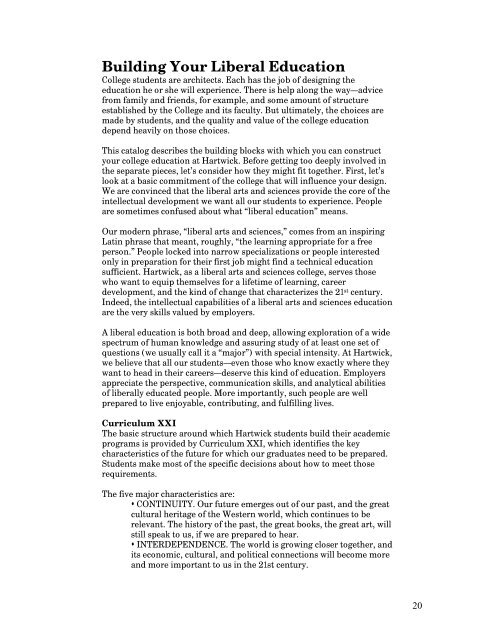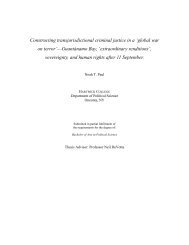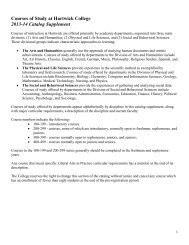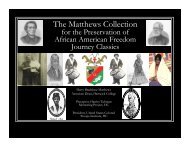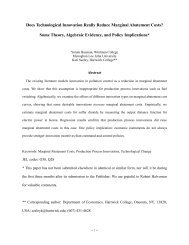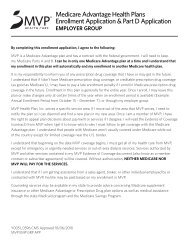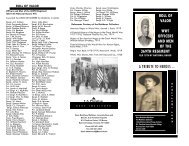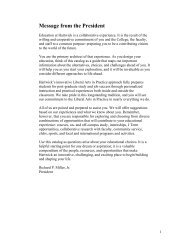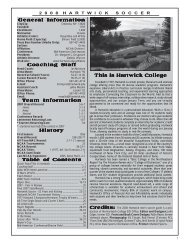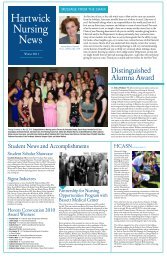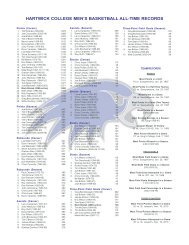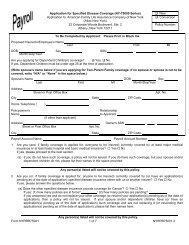Table of Contents - Hartwick College
Table of Contents - Hartwick College
Table of Contents - Hartwick College
You also want an ePaper? Increase the reach of your titles
YUMPU automatically turns print PDFs into web optimized ePapers that Google loves.
Building Your Liberal Education<br />
<strong>College</strong> students are architects. Each has the job <strong>of</strong> designing the<br />
education he or she will experience. There is help along the way—advice<br />
from family and friends, for example, and some amount <strong>of</strong> structure<br />
established by the <strong>College</strong> and its faculty. But ultimately, the choices are<br />
made by students, and the quality and value <strong>of</strong> the college education<br />
depend heavily on those choices.<br />
This catalog describes the building blocks with which you can construct<br />
your college education at <strong>Hartwick</strong>. Before getting too deeply involved in<br />
the separate pieces, let’s consider how they might fit together. First, let’s<br />
look at a basic commitment <strong>of</strong> the college that will influence your design.<br />
We are convinced that the liberal arts and sciences provide the core <strong>of</strong> the<br />
intellectual development we want all our students to experience. People<br />
are sometimes confused about what “liberal education” means.<br />
Our modern phrase, “liberal arts and sciences,” comes from an inspiring<br />
Latin phrase that meant, roughly, “the learning appropriate for a free<br />
person.” People locked into narrow specializations or people interested<br />
only in preparation for their first job might find a technical education<br />
sufficient. <strong>Hartwick</strong>, as a liberal arts and sciences college, serves those<br />
who want to equip themselves for a lifetime <strong>of</strong> learning, career<br />
development, and the kind <strong>of</strong> change that characterizes the 21 st century.<br />
Indeed, the intellectual capabilities <strong>of</strong> a liberal arts and sciences education<br />
are the very skills valued by employers.<br />
A liberal education is both broad and deep, allowing exploration <strong>of</strong> a wide<br />
spectrum <strong>of</strong> human knowledge and assuring study <strong>of</strong> at least one set <strong>of</strong><br />
questions (we usually call it a “major”) with special intensity. At <strong>Hartwick</strong>,<br />
we believe that all our students—even those who know exactly where they<br />
want to head in their careers—deserve this kind <strong>of</strong> education. Employers<br />
appreciate the perspective, communication skills, and analytical abilities<br />
<strong>of</strong> liberally educated people. More importantly, such people are well<br />
prepared to live enjoyable, contributing, and fulfilling lives.<br />
Curriculum XXI<br />
The basic structure around which <strong>Hartwick</strong> students build their academic<br />
programs is provided by Curriculum XXI, which identifies the key<br />
characteristics <strong>of</strong> the future for which our graduates need to be prepared.<br />
Students make most <strong>of</strong> the specific decisions about how to meet those<br />
requirements.<br />
The five major characteristics are:<br />
• CONTINUITY. Our future emerges out <strong>of</strong> our past, and the great<br />
cultural heritage <strong>of</strong> the Western world, which continues to be<br />
relevant. The history <strong>of</strong> the past, the great books, the great art, will<br />
still speak to us, if we are prepared to hear.<br />
• INTERDEPENDENCE. The world is growing closer together, and<br />
its economic, cultural, and political connections will become more<br />
and more important to us in the 21st century.<br />
20


